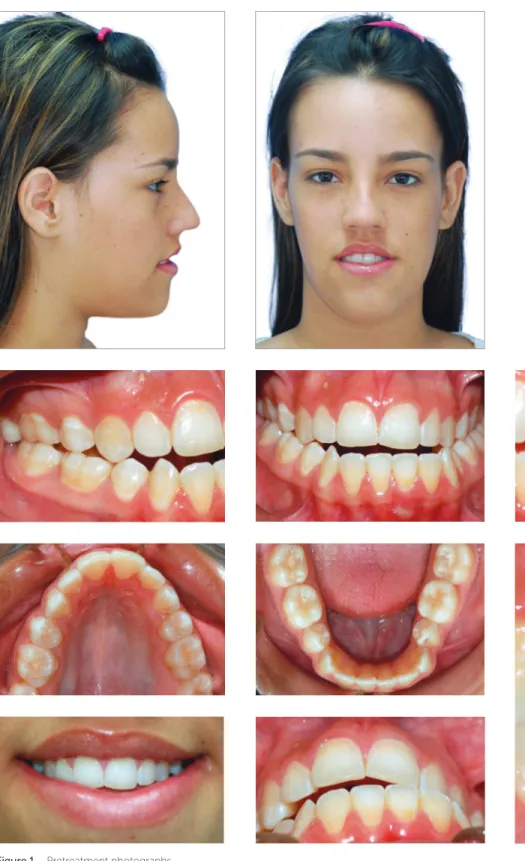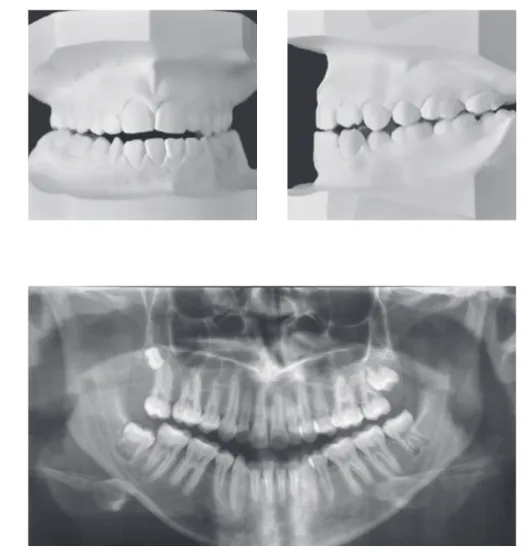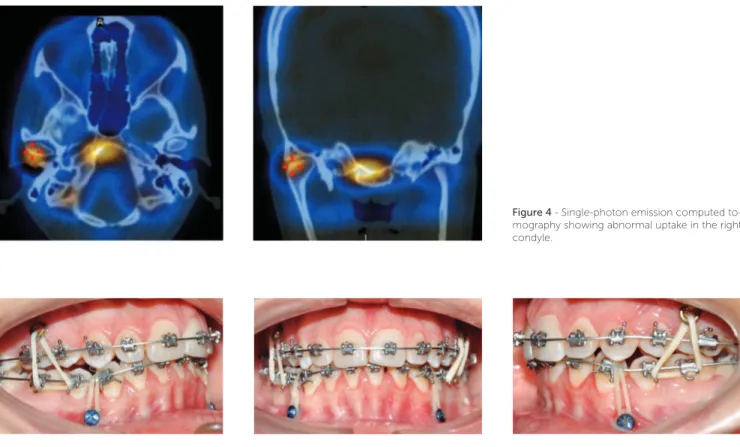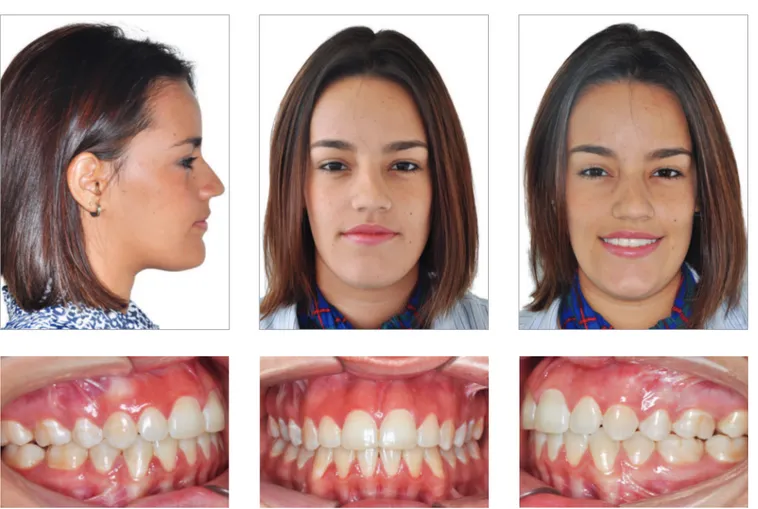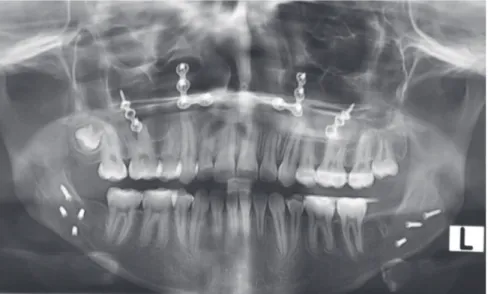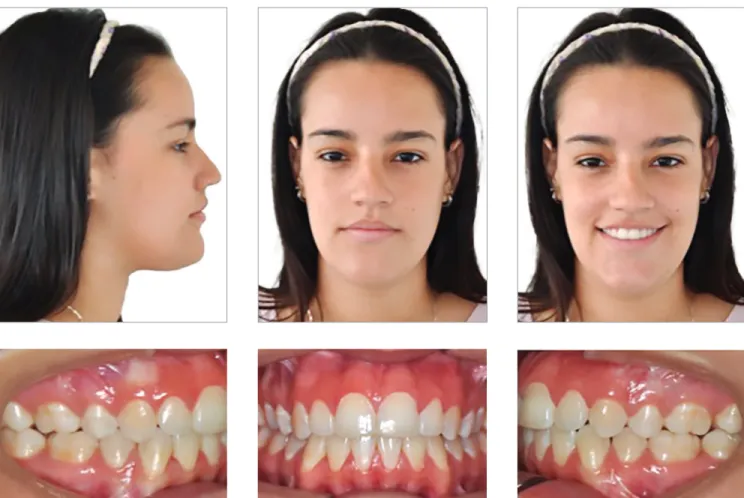Diego Fernando López1, Juan Fernando Aristizábal1, Rosana Martínez-Smit2
Condylar Hyperplasia (CH) is a self-limiting pathology condition that produces severe facial deformity at the expense of mandibular asymmetry. In this case report a 15-year-old female patient was diagnosed with Unilateral Condylar Hiper-plasia (UCH) by mean of single-photon emission computed tomography (SPECT) and histological study. A high con-dylectomy in the right condyle was performed to stop the active status of the hyperplasia. A month after concon-dylectomy, orthognathic jaw impaction and asymmetric mandibular setback surgery was performed with the Surgery First Approach (SFA). After 10 days, orthodontic appointments were made every two weeks during 4 months. The active phase of treat-ment lasted 14 months. Excellent facial and occlusal outcomes were obtained and after 24 months in retention the results remained stable.
Keywords:Condylar hyperplasia. Surgery first. Orthodontics.
1 Universidad del Valle, Facultad de Salud, Escuela de Odontología,
Departamento de Ortodoncia (Cali/ Valle del Cauca, Colombia). 2 Universidad CES, Facultad de Odontología, Departamento de Ortodoncia
(Medellín/Antioquia, Colombia).
» The authors report no commercial, proprietary or financial interest in the products or companies described in this article.
DOI: https://doi.org/10.1590/2177-6709.22.4.086-096.oar
How to cite: López DF, Aristizábal JF, Martínez-Smit R. Condylectomy and “surgery first” approach: An expedited treatment for condylar hyperplasia in a pa-tient with facial asymmetry. Dental Press J Orthod. 2017 July-Aug;22(4):86-96. DOI: https://doi.org/10.1590/2177-6709.22.4.086-096.oar
Submitted: March 03, 2016 - Revised and accepted: December 12, 2016
» Patients displayed in this article previously approved the use of their facial and in-traoral photographs.
Contact address: Rosana Martínez-Smit
Carrera 48 # 12sur – 70 Edificio Profesional el Crucero Oficina 603 Medellin- Antioquia, Colombia – E-mail: Rosana29@gmail.com
A hiperplasia condilar (HC) é uma condição patológica autolimitante que produz deformidades faciais severas devido à assimetria mandibular. Nesse estudo de caso, uma paciente de 15 anos de idade foi diagnosticada com hiperplasia con-dilar unilateral (HCU), por meio de uma tomografia computadorizada por emissão de fóton único (SPECT) e de um estudo histológico. Uma condilectomia alta no côndilo direito foi realizada para interromper o status ativo da hiperplasia. Um mês após o procedimento, foram realizadas a impacção ortognática de maxilar e a cirurgia de retroposicionamento assimétrico da mandíbula, por meio de abordagem do tipo benefício antecipado. Depois de 10 dias, consultas ortodôn-ticas passaram a ser feitas a cada duas semanas, durante 4 meses. A fase ativa do tratamento durou 14 meses. Excelentes resultados oclusais e faciais foram obtidos e, após 24 meses de contenção, os resultados permaneceram estáveis.
INTRODUCTION
Condylar Hyperplasia (CH) is a self-limiting pathology condition that produces severe facial de-formity at the expense of mandibular asymmetry1. It is commonly found in patients aged 11 to 25 years in its active form.2 It is characterized by exagger-ated and progressive growth of the condyle’s head and neck, the ramus and the body of the mandible. Affects the facial esthetics, masticatory function and the joint health. It has been reported to be more prevalent in women than in men.3,4
The CH etiology is due to factors that may be ge-netic, traumatic, functional, hormonal and tumor-related.5,6 The diagnosis of CH should be performed by a combination of clinical and radiological findings and then corroborated by means of medicine nuclear test such as scintigraphy1, 4 and bone scan SPECT (Single-photon emission computed tomography) which is a sensitive and accurate method of detect-ing the growth activity of this disorder. This meth-od can be used to quantitate the radionuclide up-take differences between the left and right condyles. Uptake differences of 10% or more between the left and right condyles, with increased uptake ipsilateral to the CH, are considered to be evidence of active growing CH. Quantitative assessment of CH is im-portant to select an appropriate treatment course. Degenerative arthropathies of the temporomandib-ular joints may result in altered uptake, but this is mostly associated with the side contralateral to the CH. The CT portion of SPECT/CT is useful to as-sess the condylar dimensions and underlying bony changes. Bone scan SPECT also has demonstrated a superior performance in this application to planar imaging through the accurate and quantifiable as-sessment of mandibular condylar growth.7-9 The CT portion of SPECT/CT provides detailed anatomic information associated with growth activity.
Early diagnosis is important since treatment mo-dalities considerably differ depending on the affected structures, patient’s age, severity of the asymmetry and the active or passive status of the pathology.1,4
In many cases when the pathology is active, besides removing the growth site in the condyle, is necessary to perform orthognatic surgery to correct the defor-mity.10 Usually in the irst place the condylar surgery is performed, then orthodontic treatment and inally
orthognatic surgery.11,12 But recently the “Surgery First Approach” (SFA) might be an option.
SFA recently introduced avoids deterioration of aesthetics and function especially in cases of skeletal Class III due to the absence of pre-surgical orthodon-tics13-17. Also, patients can beneit from immediate improvement of facial proile ater surgery and shorter treatment time.13-17 Reduction of treatment time is possible because the regional acceleration phenom-enon (RAP)18 and the dental decompensation is par-tially solved by the surgery.19
RAP is a complex physiological process with spe-ciic characteristics that includes rapid bone remodel-ing and loss of regional bone density. RAP increases tissue reorganization and healing by means of transi-tory increase of localized bone resorption and further remodeling.20,21 This is the explanation of the accel-eration of the tooth movement for a period of 4 to 5 months approximately.
The purpose of this report is to present a case of a Class III asymmetric patient with condylar hyper-plasia in which SFA was used combined with con-dylectomy.
DIAGNOSIS AND ETIOLOGY
A 15-year-old female patient, no medical back-ground, previous orthodontic treatment with premolar extractions, looking for retreatment, with the follow-ing chief complaint: “Ater the orthodontic treatment my face is deviated and the occlusion is very unstable”. During the functional analysis the patient was diagnosed with tongue thrust, mandibular delection to the let side and lip incompetence. The patient had a concave pro-ile, increased lower facial third, short upper lip, com-missure asymmetry with maxillary and occlusal planes canted (Fig 1 and Table 1).
The patient presented a Class III malocclusion, pos-terior crossbite, anpos-terior open bite, narrow arches and lower midline deviated to the let side (Figs 1 and 2).
Skeletally she presented a Class III hyperdiver-gent pattern, dolichofacial biotype and severe ret-roclined lower incisor; long, thin and asymmetrical condyles (Fig 3).
Figure 2 - Pretreatment dental casts.
Figure 3 - Pretreatment radiographs.
Measurement T1 T2
SNA 77o 76o
SNB 78o 75o
ANB -1o 1o
WITS -5 mm -1 mm
U1 - PP 110º 111o
IMPA 84º 89o
S-N/ Go-Gn 41º 33o
Ar-Go-Me 137º 129o
ANS-Me 81 mm 71 mm
Co-Gn 129 mm 122 mm
Na-Me/ S-Go 59.3% 62%
Table 1 - Cephalometric measurements: Initial cephalogram (T1) and final
cephalogram (T2).
TREATMENT OBJECTIVES
Both the skeletal and dental objectives of the treat-ment plan were closely related, which included: 1) To stop condylar hyperplasia, 2) To ix skeletal dis-crepancy, 3) To correct the malocclusion and aesthetic requirements of the patient.
TREATMENT ALTERNATIVES
Having in mind that the patient’s chief concern was her facial esthetics, it was decided to go on with surgical treatment. SFA was chosen because the patient wanted immediate facial change, avoiding deterioration of her proile and malocclusion, and also taking advantage of all the biological potential of regional acceleration.
TREATMENT PROGRESS
A high condylectomy in the right condyle was per-formed to stop the active status of the hyperplasia, re-moving 5 mm of height from medial pole to lateral pole. The specimen was sent to pathology and histological re-port showed signiicant extensions of cartilage that ex-ceeded the osteochondral junction and increase in the thickness of the layers of the condyle.
One day before surgery, interactive self-ligating brackets (In-Ovation R CCO®, 0.022 x 0.028-in slot, GAC International Inc., Bohemia, USA) were bonded, and thermoelastic 0.014-in Sentalloy arches (Dentsply GAC) were placed before starting surgery.
A month ater condylectomy, an orthognathic jaw impaction and asymmetric mandibular setback surgery was performed with the SFA. It was decided to leave
Figure 4 - Single-photon emission computed to-mography showing abnormal uptake in the right condyle.
Figure 5 - Post-surgical occlusion.
zygomatic plates (Y-shaped plate, Zimmer Biomet) for vertical control of posterior teeth using ¼-in 4.5 oz inter-maxillary elastics (Ortho Organizers Inc.) from the zy-gomatic plate to the lower posterior teeth, and 1.6 x 6 mm miniscrews (Royal Brand) between canines and lower bicuspids, for vertical control of the anterior teeth using 3/16-in 4.5 oz intermaxillary elastics (Ortho Organizers Inc.) from the miniscrews to canines and also both sys-tems could assist with the postoperative sagittal control (Fig 5). The surgeon removed the lower second molars buccal tubes during the surgical procedure in order to fa-cilitate the lower third molars extraction.
After 10 days, orthodontic controls were made every two weeks during 4 months. This stage was completed with orofacial physiotherapy to help the lymphatic drainage, neuromuscular rehabilitation and neurosensory recovery.
The active phase of treatment lasted 14 months and fixed appliances were removed to start the reten-tion stage.
TREATMENT RESULTS
Post-treatment records conirmed that treatment was able to optimize the patient’s facial and dental es-thetics, showing a considerable enhancement of the proile, correction of the Class III skeletal pattern and
mandibular deviation, decreased lower facial height, improvement of the overjet and overbite, and alignment of the dental arches into a functional Class I occlusion (Figs 6, 7 and 8, Table 1).
The superimposition showed decreased lower facial height and mandibular efective length, with counter-clockwise rotation of mandible and maxilla (Fig 9).
Ater 24 months in retention the results remained stable (Fig 10).
Figure 7 - Final radiographs.
Figure 9 - Superimposition: Initial and final ceph-alograms.
craniosynostosis. These causes may be grouped into two categories; however, there is some overlap. First, alteration of the cranial base may result in a laterally deviated mandible caused by the malpositioned gle-noid fossa. This cranial base alteration group includes muscular torticollis, unilateral coronal craniosynos-tosis and deformational plagiocephaly. Second, con-dylar abnormality may result in a laterally deviated mandible from a hypoplasia or hyperplasia growth disturbance at the condylar site. This condylar ab-normality group includes condylar fractures, condy-lar hyperplasia, hemifacial microsomia, and juvenile condylar arthritis. Proper diagnosis and subsequent treatment of the underlying abnormality of the devi-ated mandible ensure the patient of the appropriate orthognathic reconstruction and decrease the likeli-hood of skeletal relapse after surgery.23
Hyperplasia is deined as the growth of the number of cells present in a certain tissue with no increase in their size. When this afects the mandibular condylar head, it is called CH and is characterized by alterations in both the condylar and facial morphology.10
The histological report of this patient showed sig-niicant extensions of cartilage that exceeded the os-teochondral junction, and increase in the thickness of the layers of the condyle, these characteristics were consistent with active condylar hyperplasia. Classiica-tions have been developed in an attempt to standardize the concept of CH and its treatment,24 establishing a series of parameters associated with its clinical presen-tation and the conditions of diagnosis and treatment. The classiication proposed by Slootweg and Müller25 includes limited histological aspects within the param-eters; they established that diferent degrees of inva-sion of ibrocartilage islands are associated with the degree of aggressiveness of CH, classifying this from level 1 to 4. Saridin et al26 recently performed a his-topathological study of unilateral condylar hyperplasia (UCH) using the classiication proposed by Slootweg
It is very important to establish a proper diagnosis of UCH to determine opportune treatment protocol that allows detain the progression of the disease and correct the aesthetic and functional consequences it produces.27,28 Also diagnosis and early intervention, prevent the establishment of facial asymmetry, as this is considered the main cause of postnatal facial asymme-tries.7 The gold standard for diagnosis of UCH is cor-relating the clinical indings with the bone scan;29 once established, the next step is to determine whether this is an active or passive status, by means of a SPECT,30 for establishing whether cellular uptake osteoblast on suspicious condyle.31 A recent meta-analysis compared the sensitivity (true positive) and speciicity (true neg-ative) of a planar bone scan and the SPECT scanning technique in the diagnosis of UCH32 The sensitivity of the single photon emission computed tomography scan (0.91) was higher than that for the planar bone scan (0.70), whereas the speciicity for the two tech-niques was similar (0.9).
When the active state of the UCH is checked, the surgical protocol varies according to the patient’s age and asymmetry severity, but generally the treatment options proposed to date recommended condyle sur-gery and surgical correction of sequelae by orthogna-thic surgery, as the therapeutic approach of choice.8,33,34 In the present case the active state of UCH in the patient necessarily demanded a high condylectomy, but additionally, its consequences required an addi-tional therapeutic approach as orthognathic surgery that could be done ater an orthodontic preparation or, as it was performed, with SFA.
1. Nitzan DW, Katsnelson A, Bermanis I, Brin I, Casap N. The clinical characteristics of condylar hyperplasia: experience with 61 patients. J Oral Maxillofac Surg. 2008 Feb;66(2):312-8.
2. Eslami B, Behnia H, Javadi H, Khiabani KS, Safar AS. Histopathologic comparison of normal and hyperplastic condyles. Oral Surg Oral Med Oral Pathol Oral Radiol Endod. 2003 Dec;96(6):711-7.
3. Raijmakers PG, Karssemakers LH, Tuinzing DB. Female predominance and
efect of gender on unilateral condylar hyperplasia: a review and meta-analysis. J Oral Maxillofac Surg. 2012 Jan;70(1):e72-6.
4. López DF, Corral C. Hiperplasia condilar: características, manifestaciones, diagnóstico y tratamiento. Rev Fac Odontol Univ Antioq. 2015;26(2):78-99.
5. Obwegeser HL, Makek MS. Hemimandibular hyperplasia-hemimandibular
elongation. J Maxillofac Surg. 1986 Aug;14(4):183-208.
6. Villanueva-Alcojol L, Monje F, González-García R. Hyperplasia of the mandibular condyle: clinical, histopathologic, and treatment considerations in a series of 36 patients. J Oral Maxillofac Surg. 2011 Feb;69(2):447-55.
7. Wen B, Shen Y, Wang CY. Clinical value of 99Tcm-MDP SPECT bone
scintigraphy in the diagnosis of unilateral condylar hyperplasia. Sci World J. 2014(2014):1256256.
8. Hodder SC, Rees JI, Oliver TB, Facey PE, Sugar AW. SPECT bone scintigraphy in the diagnosis and management of mandibular condylar hyperplasia. Br J Oral Maxillofac Surg. 2000 Apr;38(2):87-93.
9. Alyamani A, Abuzinada S. Management of patients with condylar hyperplasia: a diverse experience with 18 patients. Ann Maxillofac Surg. 2012 Jan;2(1):17-23.
REFERENCES
10. Olate S, Duque H, Rodriguez J, Alister J, Barbosa A, Moraes M. Mandible condylar hyperplasia: a review of diagnosis and treatment protocol. Int J Clin Exp Med. 2013;6(9):727-37.
11. Muñoz MF, Monje F, Goizueta C, Rodríguez-Campo F. Active condylar hyperplasia treated by high condilectomy: report of case. J Oral Maxillofac Surg. 1999 Dec;57(12):1455-9.
12. Angiero F, Farronato G, Benedicenti S, Vinci R, Farronato D, Magistro S, et al. Mandibular condylar hyperplasia: clinical, histopathological, and treatment considerations. Cranio. 2009 Jan;27(1):24-32.
13. Villegas C, Uribe F, Sugawara J, Nanda R. Expedited correction of signiicant dentofacial asymmetry using a “surgery irst” approach. J Clin Orthod. 2010 Feb;44(2):97-103; quiz 105.
14. Villegas C, Janakiraman N, Uribe F, Nanda R. Rotation of the maxilla mandibular complex to enhance esthetics using a “surgery irst” approach. J Clin Orthod. 2012 Feb;46(2):85-91.
15. Hong KJ, Lee JG. 2 phase treatment without preoperative orthodontics in skeletal Class III malocclusion. Korean J Oral Maxillofac Surg. 1999;25:48-53. 16. Nagasaka H, Sugawara J, Kawamura H, Nanda R. “Surgery irst” skeletal
Class III correction using the skeletal anchorage system. J Clin Orthod. 2009 Feb;43(2):97-105.
17. Aristizábal JF, Martínez Smit R, Villegas C. The “surgery irst” approach with passive self-ligating brackets for expedited treatment of skeletal Class III malocclusion. J Clin Orthod. 2015 June;49(6):361-70.
in the occlusion.35-43 Even though these procedures usually have a positive outcome,44 disadvantages such as longer treatment time, deterioration of aesthetics and function are present during the pre-surgery orth-odontic phase.45
In the classical approach, pre-surgery orthodontics usually takes up from 15 to 17 months,46,47 or even 24 months.48 Post-surgery orthodontics lasts between 7 and 12 months.48 In contrast, if orthognathic sur-gery is performed before the orthodontic treatment, total treatment time can be signiicantly reduced, and it would last even less than the average time it takes only to complete pre-surgery orthodontics.46,47,49
In this speciic case, it was decided to do irst the con-dylectomy and in second place the orthognathic surgery, having in mind that if the condylectomy and orthogna-thic surgery are done simultaneously, the intra-articular, skeletal, muscular and functional relationship are altered at the same time. Also, ater condylectomy the condyle
dramatically changes its position and afects its relation-ship with the joint, therefore the type and magnitude of orthognathic surgery could change.50
In this case report with the combination of proper diagnosis, excellent communication with the maxillo-facial surgeon during the planning of surgical treatment composed by condylectomy and orthognatic surgery with SFA, and post-surgical orthodontics using tempo-rary anchorage devices, it was possible to solve the aes-thetic and functional problem of this patient with UCH.
CONCLUSIONS
The relationship between a correct diagnosis, the importance of the timing of intervention and proper biomechanics showed aesthetic and functional results in this case of asymmetry.
condylar hyperplasia. J Craniomaxillofac Surg. 2016 Jan;44(1):70-4. 23. Kawamoto HK, Kim SS, Jarrahy R, Bradley JP. Diferential diagnosis of
the idiopathic laterally deviated mandible. Plast Reconstr Surg. 2009 Nov;124(5):1599-609.
24. Wolford LM, Movahed R, Perez DE. A classification system for conditions causing condylar hyperplasia. J Oral Maxillofac Surg. 2014 Mar;72(3):567-95.
25. Slootweg PJ, Müller H. Condylar hyperplasia. A clinico-pathological analysis of 22 cases. J Maxillofac Surg. 1986 Aug;14(4):209-14.
26. Saridin CP, Raijmakers PG, Slootweg PJ, Tuinzing DB, Becking AG, van der Waal I. Unilateral condylar hyperactivity: a histopathologic analysis of 47 patients. J Oral Maxillofac Surg. 2010 Jan;68(1):47-53.
27. Diaz PM, Garcia RG, Gias LN, Aguirre-Jaime A, Pérez JS, de la Plata MM, et al. Time used for orthodontic surgical treatment of dentofacial deformities in white patients. J Oral Maxillofac Surg. 2010 Jan;68(1):88-92. 28. Luther F, Morris DO, Karnezi K. Orthodontic treatment following
orthognathic surgery: how long does it take and why? A retrospective study. J Oral Maxillofac Surg. 2007 Oct;65(10):1969-76.
29. Saridin CP, Raijmakers P, Becking AG. Quantitative analysis of planar bone scintigraphy in patients with unilateral condylar hyperplasia. Oral Surg Oral Med Oral Pathol Oral Radiol Endod. 2007 Aug;104(2):259-63.
30. Elbaz J, Wiss A, Raoul G, Leroy X, Hossein-Foucher C, Ferri J. Condylar hyperplasia: correlation between clinical, radiological, scintigraphic, and histologic features. J Craniofac Surg. 2014 May;25(3):1085-90. 31. Wolford LM, Morales-Ryan CA, García-Morales P, Peréz D. Surgical
management of mandibular condylar hyperplasia type 1. Proc (Bayl Univ Med Cent). 2009 Oct;22(4):321-9.
32. Saridin CP, Raijmakers PG, Tuinzing DB, Becking AG. Bone scintigraphy as a diagnostic method in unilateral hyperactivity of the mandibular condyles: a review and meta-analysis of the literature. Int J Oral Maxillofac Surg. 2011 Jan;40(1):11-7.
33. Gn S, Sharma ML, Jk DR, Goel S, Srivastava S. Facial asymmetry in young adults with condylar hyperplasia-unusual changes in the facial bones. J Clin Diagn Res. 2015 Jan;9(1):ZD21-3.
planning: proile analysis and mandibular surgery. Angle Orthod. 1976 Jan;46(1):1-25.
39. Vig KD, Ellis E 3rd. Diagnosis and treatment planning for the surgical-orthodontic patient. Dent Clin North Am. 1990 Apr;34(2):361-84. 40. Verdier M, Ghadanfar A, Coutant A, et al. Planning of pre- and post-surgical
orthodontic alignments. Rev Stomatol Chir Maxillofac. 1994;95(2):144-5. 41. Proit WR, Miguel JA. The duration and sequencing of surgical-orthodontic
treatment. Int J Adult Orthodon Orthognath Surg. 1995;10(1):35-42. 42. Bousaba S, Delatte M, Barbarin V, Faes J, De Clerck H. Pre- and
post-surgical orthodontic objectives and orthodontic preparation. Rev Belge Med Dent (1984). 2002;57(1):37-48.
43. Proit WR, White RP. Combining surgery and orthodontics: who does what, when? In: Proit WR, White RP, Sarver DM, editors. Contemporary treatment of dentofacial deformity. St Louis: Mosby; 2003. p. 245-67. 44. Sabri R. Orthodontic objectives in orthognathic surgery: state of the art
today. World J Orthod. 2006 Summer;7(2):177-91.
45. Proit WR, Turvey TA, Phillips C. The hierarchy of stability and predictability in orthognathic surgery with rigid ixation: an update and extension. Head Face Med. 2007;3:21.
46. Cunningham SJ, Hunt NP, Feinmann C. Perceptions of outcome following orthognathic surgery. Br J Oral Maxillofac Surg. 1996 June;34(3):210-3. 47. Nurminen L, Pietilä T, Vinkka-Puhakka H. Motivation for and satisfaction
with orthodontic-surgical treatment: a retrospective study of 28 patients. Eur J Orthod. 1999 Feb;21(1):79-87.
48. Luther F, Morris DO, Hart C. Orthodontic preparation for orthognathic surgery: How long does it take and why? A retrospective study. Br J Oral Maxillofac Surg. 2003 Dec;41(6):401-6.
49. Dowling PA, Espeland L, Krogstad O, Stenvik A, Kelly A. Duration of orthodontic treatment involving orthognathic surgery. Int J Adult Orthodon Orthognath Surg. 1999;14(2):146-52.
